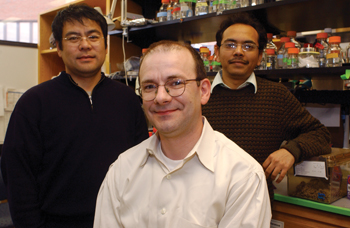
Luc Van Kaer, Ph.D., center, with research fellows Jingbo Yan, Ph.D., and Vrajesh Parekh, Ph.D.
Photo by Dana Johnson
Protein ‘trimming’ may aid vaccine research
Although it may be impossible to remember the faces and names of all the people you've met in your lifetime — and whether they were 'friend' or 'foe' — the immune system is taxed with just such as task.
It must recognize an almost infinite number of proteins as 'self' (friend) or 'foreign' (foe) and choose the appropriate action — ignore the friends or destroy the foes.
In the March issue of the Journal of Experimental Medicine, Vanderbilt's Luc Van Kaer, Ph.D., and colleagues show that a protein-trimming enzyme, ERAP1, may hold the key to mounting an appropriate immune response by tailoring both foreign and self proteins for their final presentation to immune cells. The new information could help researchers develop better vaccines against viruses and cancer.
The molecules at the heart of the immune response are encoded by the major histocompatibility complex (MHC), a genetic locus on chromosome 6 in humans. MHC molecules were originally identified as the molecules responsible for transplant rejection. When donor and recipient MHC molecules do not match closely enough, which is the norm rather than the exception, tissue gets promptly rejected.
“If you look at genes that differ between different human beings, you will find that the highest variability between different people is within this particular locus,” said Van Kaer, professor of Microbiology and Immunology.
Obviously, these molecules didn't evolve simply to muck up tissue transplants, an artificial, human invention. Scientists now know that their normal function is to present short pieces of self and foreign proteins (e.g., viral, bacterial or parasitic proteins) to the cells of the immune system. A specific class of MHC molecules, called class I, is responsible for presenting viral and tumor protein fragments.
When a virus infects a cell, its proteins get chopped up by a large enzyme complex inside the cell. These small protein pieces (or peptides) are then shuttled to another cellular compartment (the endoplasmic reticulum, or ER) where MHC molecules lie in wait. The MHC molecules bind to the short peptides, and the complex is then packaged and shuttled to the cell's outer membrane. A set of white blood cells, the T-cells, see the MHC-viral peptide complex on the infected cell's surface and target it for destruction.
“The virally infected cell 'advertises' to the immune system that it's been infected by putting at the cell surface an MHC class I molecule plus a protein fragment derived from the virus,” Van Kaer said.
Sometimes the immune response doesn't go so smoothly. One possible problem is that MHC class I molecules are 'picky,' binding only to peptides of a particular length (8-10 amino acids long).
Since only about 15 percent of peptides that enter the ER are the right length for MHC binding, there must be another enzyme inside the ER that whittles away the last few amino acids from the peptides.
In the current study, Van Kaer and colleagues analyzed one potential enzyme candidate, called ERAP1, using mice genetically engineered to lack the protein.
The ERAP1-deficient mice were essentially healthy. As an indirect measure of the efficiency of peptide processing, the researchers measured how much MHC class I made it to the cell surface.
“There was about a three-fold reduction, indicating that this (enzyme) apparently helps with the overall presentation of a significant portion of these peptides,” Van Kaer said.
The researchers then took cells from the mice, grew them in dishes and analyzed their ability to present peptides to T-cells.
“For a majority of the peptides, ERAP1 was very important,” Van Kaer said. “ERAP1 helped in getting peptide processed to the correct length. For a few others, it didn't seem to make any difference. For a few more, it turned out that it made things worse.”
Finally, the researchers infected mice with influenza virus and found that the ERAP1-deficient mice generated fewer influenza-specific T-cells than the normal mice, suggesting that ERAP1 contributes to the strength of the T-cell response to the virus.
The results suggest that, while some peptides may require ERAP1 degradation, others do not, a requirement that may have applications to vaccine development.
“Knowing the rules that determine which peptides require degradation by ERAP1 will help us to develop better vaccines for viruses and tumors,” Van Kaer said.
He hopes to someday be able to predict from a protein's sequence if it will be bind MHC molecules. In the case of tumor proteins, Van Kaer suggests that it might be possible to modify tumor proteins (so that they are more easily recognized as foreign) to develop better cancer vaccines.
Additionally, since ERAP1 also influences the presentation of 'self' proteins, the enzyme could be important for understanding autoimmune diseases, in which the immune system turns on the body's own tissues.













